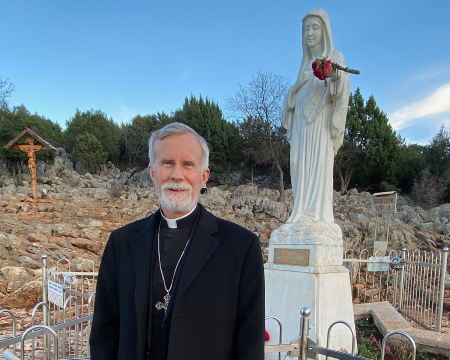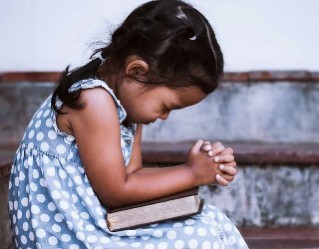The fade of intolerable Child Labor
FREE Catholic Classes
Data Point to an Encouraging Trend
GENEVA, JUNE 18, 2006 (Zenit) - On Monday the International Labor Organization marked the annual World Day against Child Labor. The ILO organized a series of events in Geneva, held within the context of the annual meeting of the organization.
"Many have said child labor will always be with us," said Juan Somavia, director-general of the ILO, in a press release dated June 7. "But the global movement against child labor is proving them wrong."
"The End of Child Labor: Within Reach" is the title of an ILO report published to coincide with this year's world day. It starts by observing how four years ago, the ILO developed a set of statistics to allow a reliable assessment of the extent of the problem. Using this methodology, the statistics in the report show that the number of child workers fell by 11% at the global level over the last four years.
Even more encouraging was the fact that the decrease is occurring most sharply in the area of hazardous work by children. The number of children in hazardous work decreased overall by 26%, and by 33% in the 5-14 age group.
In geographic terms, Latin America and the Caribbean made the greatest progress. In this region the number of children at work fell by two-thirds over the last four years, and now just 5% of children are engaged in work. The least progress has been made in sub-Saharan Africa, where the level of child labor remains high.
Millions still at work
In spite of this progress, however, large numbers of children still remain at work. In 2004 -- the latest figures available for use in this year's report -- there were 218 million children trapped in child labor. Of these, 126 million were in hazardous work.
The ILO does not seek an absolute prohibition against any form of work by children. In fact, the 2004 data estimate there are about 317 million economically active children aged 5 to 17, of whom 218 million could be regarded as child laborers.
Divided by age groups, in the range of 5- to 14-year-olds, there are 166 million child laborers, and 74 million children in hazardous work. Boys continue to be more afflicted than girls by child labor, particularly in hazardous work. The difference becomes more pronounced with increasing age.
Child labor that is proscribed under international law falls into three categories:
-- The worst forms, defined as slavery, trafficking, debt bondage and other forms of forced labor. This includes forced recruitment of children for use in armed conflict, prostitution and pornography, and other illicit activities.
-- Labor performed by a child who is under the minimum age specified for that kind of work, and that is thus likely to impede the child's education and full development.
-- Labor that jeopardizes the physical, mental or moral well-being of a child, either because of its nature or because of the conditions in which it is carried out. This is known as "hazardous work."
Why the decline
The progress obtained is the result of many years of work on the issue, according to the ILO. In 1992 the International Program on the Elimination of Child Labor was launched. Today, the program receives funding from some 30 nations and is active in 86 countries. It is, in fact, the ILO's biggest technical cooperation program.
Another element in the reduction of child labor was the formulation of a number of conventions on the issue. The ILO Declaration on Fundamental Principles and Rights at Work was adopted in 1998. The text included the elimination of child labor as one of the four fundamental principles which ILO members undertook to respect.
This was followed by the Worst Forms of Child Labor Convention, in 1999. This document, referred to as Convention No. 182, has been ratified by 158 countries. Another document, the Minimum Age Convention, dating back to 1973 and known as Convention No. 138, has been ratified by an additional 77 nations since 1999.
Additionally, the ILO stated that the work of parliamentarians, nongovernmental organizations, consumers and public opinion in general were also important in making progress on reducing the number of children in the work force.
Reducing the practice of child labor, the report observes, is not something that happens in isolation from the rest of society. Economic growth is important, and progress has been slower where economic progress has lagged.
As well, countries need to approach this problem with a set of policies related to equality, human rights, decent work for all adults, and education for all children. The ILO also noted that both employers' and workers' organizations play a decisive role in the fight against child labor.
Another key factor, in the realm of education, is the level of school attendance. Compulsory education imposes limits on the hours of work and the nature and conditions of work, the report states. In many countries the establishment of universal schooling up to the age of 14 has signaled the effective demise of child labor, the ILO noted. Citing the examples of Brazil and China, the report said that progress in reducing child labor is the greatest when economic progress is combined with education reform.
The type of economic production also influences the degree of child labor. The higher the share of agriculture in gross national product, the higher the incidence of child labor.
Church's message
The Catholic Church has long opposed abuses committed through child labor. In fact, the first social encyclical, "Rerum Novarum," issued by Pope Leo XIII in 1891, condemned the practice. In a quote cited by the Compendium of the Social Doctrine of the Church (No. 296), Leo XIII stated that children should not be put to work before their minds and bodies are sufficiently developed.
Over a century later, in the World Day of Peace Message for 1996, Pope John Paul II wrote: "Child labor, in its intolerable forms, constitutes a kind of violence that is less obvious than others, but it is not for this reason any less terrible."
The Compendium notes that in some situations the economic contribution made by children at work can be indispensable for families and countries. Nevertheless, the Church condemns the exploitation of children in situations that are a form of veritable slavery.
Children are the future of a nation and, as such, they should be provided with nutrition, education, health and child rights, stated Father Jose Vattakkuzhy, executive secretary of the Indian bishops' Commission for Labor, in a declaration issued Monday for the ILO's world day.
In the statement, published by the Indian Catholic News Service, Father Vattakkuzhy observed that India takes first place in the world for the use of children in the work force. Poverty is one of the causes, but broken families and "vices of the head of the families," also play a part. When families are afflicted with problems of alcohol or drug addiction, sending the children out to work is often seen as the solution to the need for money, he explained.
"We can give these children a better life," he concluded. Little by little, the world seems to be concurring with that.
Contact
Catholic Online
https://www.catholic.org
CA, US
Catholic Online - Publisher, 661 869-1000
info@yourcatholicvoice.org
Keywords
Child, Labor, Children, Work, Solidarity
 Hi readers, it seems you use Catholic Online a lot; that's great! It's a little awkward to ask, but we need your help. If you have already donated, we sincerely thank you. We're not salespeople, but we depend on donations averaging $14.76 and fewer than 1% of readers give. If you donate just $5.00, the price of your coffee, Catholic Online School could keep thriving. Thank you. Help Now >
Hi readers, it seems you use Catholic Online a lot; that's great! It's a little awkward to ask, but we need your help. If you have already donated, we sincerely thank you. We're not salespeople, but we depend on donations averaging $14.76 and fewer than 1% of readers give. If you donate just $5.00, the price of your coffee, Catholic Online School could keep thriving. Thank you. Help Now >
More Catholic PRWire
Showing 1 - 50 of 4,716
A Recession Antidote
Randy Hain
Monaco & The Vatican: Monaco's Grace Kelly Exhibit to Rome--A Review of Monegasque-Holy See Diplomatic History
Dna. Maria St. Catherine Sharpe, t.o.s.m., T.O.SS.T.
The Why of Jesus' Death: A Pauline Perspective
Jerom Paul
A Royal Betrayal: Catholic Monaco Liberalizes Abortion
Dna. Maria St.Catherine De Grace Sharpe, t.o.s.m., T.O.SS.T.
Embrace every moment as sacred time
Mary Regina Morrell
My Dad
JoMarie Grinkiewicz
Letting go is simple wisdom with divine potential
Mary Regina Morrell
Father Lombardi's Address on Catholic Media
Catholic Online
Pope's Words to Pontifical Latin American College
Catholic Online
Prelate: Genetics Needs a Conscience
Catholic Online
State Aid for Catholic Schools: Help or Hindrance?
Catholic Online
Scorsese Planning Movie on Japanese Martyrs
Catholic Online
2 Nuns Kidnapped in Kenya Set Free
Catholic Online
Holy See-Israel Negotiation Moves Forward
Catholic Online
Franchising to Evangelize
Catholic Online
Catholics Decry Anti-Christianity in Israel
Catholic Online
Pope and Gordon Brown Meet About Development Aid
Catholic Online
Pontiff Backs Latin America's Continental Mission
Catholic Online
Cardinal Warns Against Anti-Catholic Education
Catholic Online
Full Circle
Robert Gieb
Three words to a deeper faith
Paul Sposite
Relections for Lent 2009
chris anthony
Wisdom lies beyond the surface of life
Mary Regina Morrell
World Food Program Director on Lent
Catholic Online
Moral Clarity
DAN SHEA
Pope's Lenten Message for 2009
Catholic Online
A Prayer for Monaco: Remembering the Faith Legacy of Prince Rainier III & Princess Grace and Contemplating the Moral Challenges of Prince Albert II
Dna. Maria St. Catherine Sharpe
Keeping a Lid on Permissiveness
Sally Connolly
Glimpse of Me
Sarah Reinhard
The 3 stages of life
Michele Szekely
Sex and the Married Woman
Cheryl Dickow
A Catholic Woman Returns to the Church
Cheryl Dickow
Modernity & Morality
Dan Shea
Just a Minute
Sarah Reinhard
Catholic identity ... triumphant reemergence!
Hugh McNichol
Edging God Out
Paul Sposite
Burying a St. Joseph Statue
Cheryl Dickow
George Bush Speaks on Papal Visit
Catholic Online
Sometimes moving forward means moving the canoe
Mary Regina Morrell
Action Changes Things: Teaching our Kids about Community Service
Lisa Hendey
Easter... A Way of Life
Paul Spoisite
Papal initiative...peace and harmony!
Hugh McNichol
Proclaim the mysteries of the Resurrection!
Hugh McNichol
Jerusalem Patriarch's Easter Message
Catholic Online
Good Friday Sermon of Father Cantalamessa
Catholic Online
Papal Address at the End of the Way of the Cross
Catholic Online
Cardinal Zen's Meditations for Via Crucis
Catholic Online
Interview With Vatican Aide on Jewish-Catholic Relations
Catholic Online
Pope Benedict XVI On the Easter Triduum
Catholic Online
Holy Saturday...anticipation!
Hugh McNichol
We ask you, humbly: don't scroll away.
Hi readers, it seems you use Catholic Online a lot; that's great! It's a little awkward to ask, but we need your help. If you have already donated, we sincerely thank you. We're not salespeople, but we depend on donations averaging $14.76 and fewer than 1% of readers give. If you donate just $5.00, the price of your coffee, Catholic Online School could keep thriving. Thank you.Help Now >











 Daily Readings for Saturday, April 20, 2024
Daily Readings for Saturday, April 20, 2024 St. Marian: Saint of the Day for Saturday, April 20, 2024
St. Marian: Saint of the Day for Saturday, April 20, 2024 Children's Prayer For Parents: Prayer of the Day for Saturday, April 20, 2024
Children's Prayer For Parents: Prayer of the Day for Saturday, April 20, 2024


